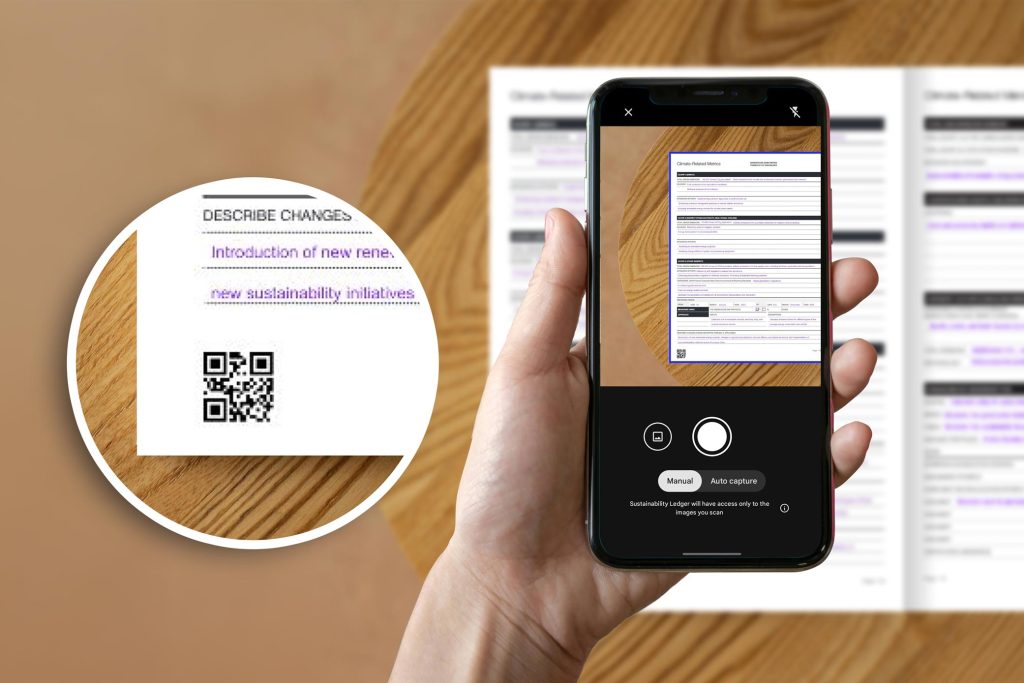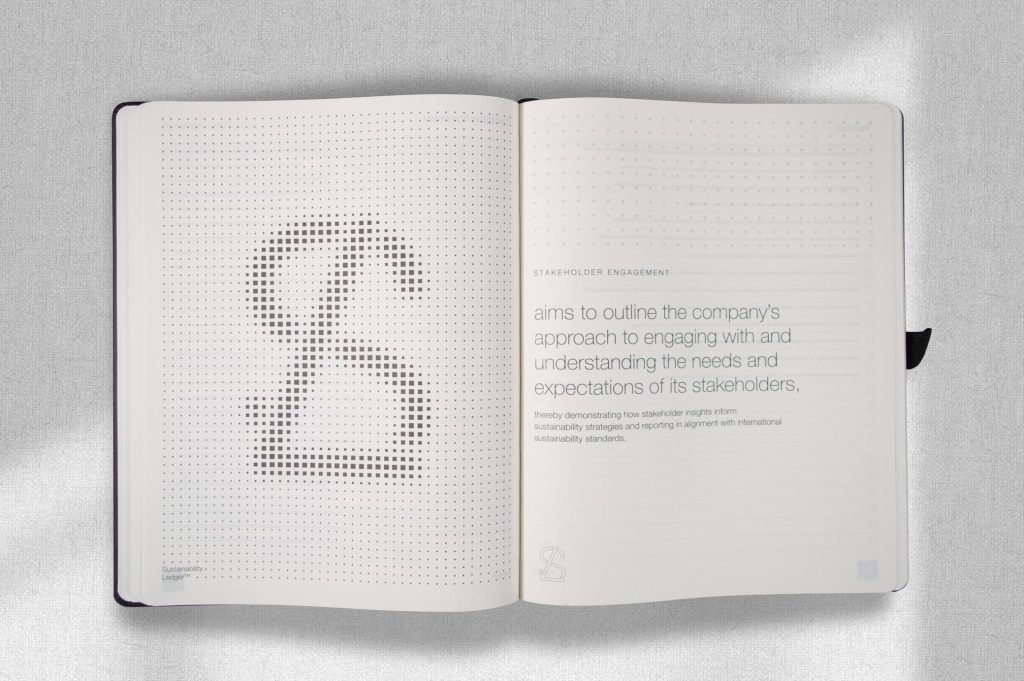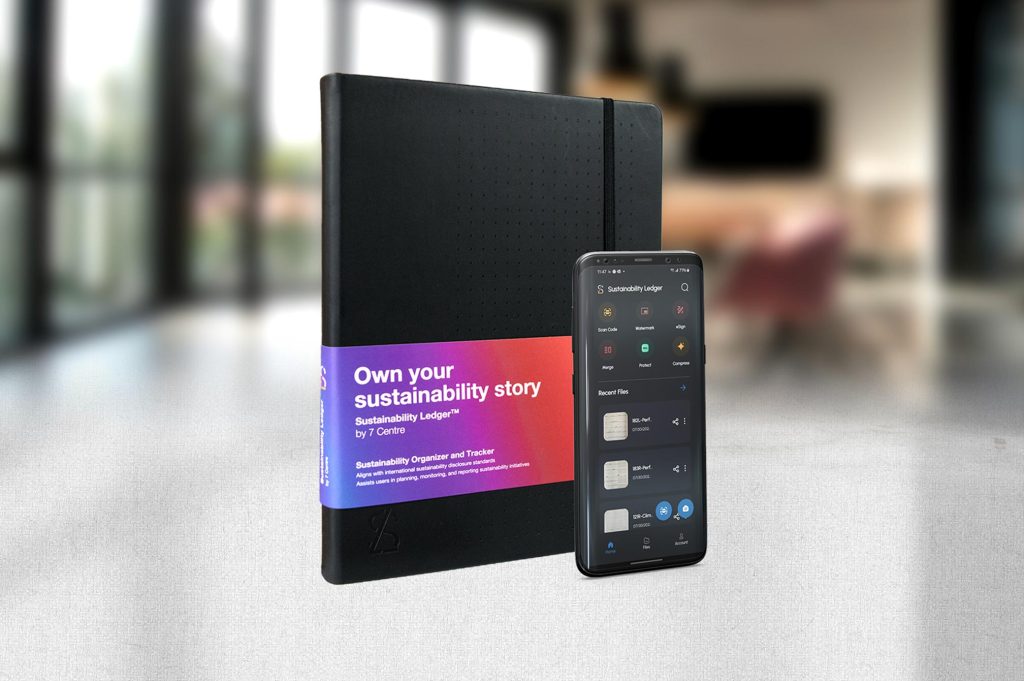
Simplii Workbook
The Workbook is a physical tool featuring QR-enabled technology designed to complement the digital platform. It streamlines sustainability data collection, supports comprehensive reporting, and equips teams for effective sustainability management.

Let's Get Started
Open your world to smarter sustainability practices. The Simplii Workbook is carefully designed to help you integrate sustainability into your daily operations, focusing on key areas that drive success.
To begin register your workbook, scan the QR code on its registration page, or contact us at info@7Centre.com.

Flexibility in Use:
- Begin on any relevant page. The workbook is designed to adapt to your workflow.
- Regularly update your workbook to integrate sustainability into your operations.

Companion App:
-
Download the Simplii Workbook companion

App for IOS and Android.
- Use the QR codes on each page of the workbook to digitize your entries.
- Merge, watermark, sign and protect your documents within the app.

Core Content Areas:
- Governance: Document roles, responsibilities, and decision-making processes.
- Strategy: Align your sustainability goals with business objectives.
- Risk Management: Identify, assess, and manage sustainability risks.
- Metrics and Targets: Set measurable goals and track your progress.

Additional Content:
- Stakeholder mapping and engagement.
- Performance Log with space for daily, weekly, monthly, and quarterly updates.
- Reference section and task lists.

International Standards
- The workbook follows the information requirements for
- ISSB's IFRS S1 and IFRS S2 sustainability standards.
- IFRS S1: General sustainability disclosures.
- IFRS S2: Climate-related disclosures.
- Use SASB Standards and SIC codes to identify relevant disclosure topics and activity metrics for your industry.
- Document relevant sections in your workbook for each core area.
- Review and update regularly.
Introduction to
The Simplii Workbook help guide for aligning with CSRD
This guide simplifies how to align your Simplii workbook with both the International Sustainability Standards Board (ISSB) and European Sustainability Reporting Standards (ESRS) to support the Corporate Sustainability Reporting Directive (CSRD). These standards are highly compatible, especially for climate-related reporting, making it easier for you to meet global sustainability disclosure requirements. Whether you start with ISSB or ESRS, this guide will help you prepare for both, focusing on materiality, presentation, and specific climate-related disclosures.
1. Materiality Assessment
Action:
-
- Double Materiality: Start by evaluating sustainability matters through the lens of double materiality. Document not only how these issues impact your company’s financial performance but also how your company affects the environment and society.
Where to Record:
- Use the Materiality definition section on page 340 in your workbook as a starting point and the Materiality Assessment Template on page 16 and 17 for additional guidance. For environmental impacts, use the Climate Strategy section beginning on page 95 to record material information.
2. Governance
Action:
- Governance Details: Record detailed information about your governance structures, including:
- Composition and diversity of governance bodies (gender, executive vs. non-executive members).
- Relevant experience in sectors, products, and geographic locations.
- How governance bodies are kept informed about sustainability matters.
Where to Record:
- In the Governance section, use the Board Matrix found on Page 8 and 9 to record these details. Ensure this information is updated regularly.
3. Strategy
Action:
- In the Stakeholder Engagement section beginning on page 141, thoroughly record all engagement activities, including details on who was involved, methods of engagement, and key insights or outcomes. This section should serve as the primary record of all stakeholder interactions.
- In the Strategy section, summarize how stakeholder input has influenced your sustainability strategy. Document how these insights have shaped your strategic decisions, goals, and action plans, ensuring that the impact of stakeholder engagement is clearly reflected in your strategy.
Where to Record:
- Stakeholder Engagement Section: Use this section to capture all detailed information about your engagement activities.
- Strategy Section: Provide a summary of how stakeholder engagement has informed and influenced your overall strategy.
4. Risk Management
Action:
- Enhanced Risk Assessment: Record how you assess the likelihood, magnitude, and nature of sustainability-related risks. Include details on how these risks are prioritized in relation to other business risks.
Where to Record:
- In the Risk Management section beginning on page 59, detail the company’s risk assessment processes. For climate-related risks, provide details starting on page 114. Document the use of risk assessment tools and methods.
5. Metrics and Targets
Action:
- Disaggregation of GHG Emissions: Break down your Scope 1 and Scope 2 greenhouse gas emissions. Ensure they are categorized between the consolidated accounting group and other investees.
- Comprehensive Target Setting: Record gross greenhouse gas reduction targets and ensure they align with the CSRD requirements. Avoid labeling net targets as gross reductions.
Where to Record:
- Use the Metrics and Targets section beginning on page 124 to capture this additional data. Include clear definitions and explanations for each target.
6. Scenario Analysis
Action:
- Scenario Disclosure: Provide detailed documentation on how you use scenario analysis for climate resilience. Make sure to state whether you’ve used scenarios aligned with international agreements like the Paris Agreement.
Where to Record:
- In the Climate-themed section, record details beginning on page 112.
7. Carbon Credits
Action:
- Carbon Credit Reporting: Document only carbon credits verified against recognized quality standards. Differentiate between carbon credits and other greenhouse gas removal projects.
Where to Record:
- in the climate-themed Metrics and Targets section beginning on page 124, record information about carbon credits. Include details on verification, quality standards, and the credibility of the credits used.
8. Use of Industry-Based Metrics
Action:
- Industry Metrics: Refer to relevant sector-specific standards to identify and document applicable industry-based metrics.
Where to Record:
- In each relevant section (e.g., Strategy, Metrics and Targets), ensure that industry-specific metrics are recorded and clearly labeled.
9. Additional Disclosure Requirements
Action:
- Incremental Disclosures: Include any additional data points required by ESRS, such as incentive schemes, due diligence processes, and internal controls over sustainability reporting.
Where to Record:
- Expand the relevant sections (Governance, Strategy, Risk Management) to incorporate these incremental disclosures. Use clear headings and labels to ensure all information is easily accessible.
10. Assurance and Verification
Action:
- Assurance Documentation: Record the extent of assurance provided for your sustainability data. Include details about the verification process and third-party involvement.
Where to Record:
- In the Metrics and Targets sections, confirm if the information has been verified and identify the 3rd Regularly update this information as new assurances are conducted.
